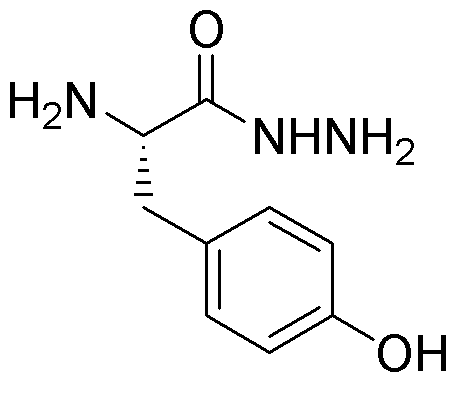L-Tyrosine hydrazide is widely utilized in research focused on:
- Pharmaceutical Development: This compound serves as a precursor in the synthesis of various pharmaceuticals, particularly those targeting neurological disorders, enhancing drug efficacy.
- Biochemical Research: It is employed in studies related to protein synthesis and enzyme activity, providing insights into metabolic pathways and cellular functions.
- Antioxidant Formulations: L-Tyrosine hydrazide is used in developing antioxidant products, helping to protect cells from oxidative stress and improve overall health.
- Food Industry: It acts as a flavor enhancer and preservative in certain food products, contributing to improved taste and shelf life.
- Cosmetic Applications: The compound is included in skincare formulations for its potential to promote skin health and combat signs of aging.
General Information
Properties
Safety and Regulations
Applications
L-Tyrosine hydrazide is widely utilized in research focused on:
- Pharmaceutical Development: This compound serves as a precursor in the synthesis of various pharmaceuticals, particularly those targeting neurological disorders, enhancing drug efficacy.
- Biochemical Research: It is employed in studies related to protein synthesis and enzyme activity, providing insights into metabolic pathways and cellular functions.
- Antioxidant Formulations: L-Tyrosine hydrazide is used in developing antioxidant products, helping to protect cells from oxidative stress and improve overall health.
- Food Industry: It acts as a flavor enhancer and preservative in certain food products, contributing to improved taste and shelf life.
- Cosmetic Applications: The compound is included in skincare formulations for its potential to promote skin health and combat signs of aging.
Documents
Safety Data Sheets (SDS)
The SDS provides comprehensive safety information on handling, storage, and disposal of the product.
Product Specification (PS)
The PS provides a comprehensive breakdown of the product’s properties, including chemical composition, physical state, purity, and storage requirements. It also details acceptable quality ranges and the product's intended applications.
Certificates of Analysis (COA)
Search for Certificates of Analysis (COA) by entering the products Lot Number. Lot and Batch Numbers can be found on a product’s label following the words ‘Lot’ or ‘Batch’.
*Catalog Number
*Lot Number
Certificates Of Origin (COO)
This COO confirms the country where the product was manufactured, and also details the materials and components used in it and whether it is derived from natural, synthetic, or other specific sources. This certificate may be required for customs, trade, and regulatory compliance.
*Catalog Number
*Lot Number
Safety Data Sheets (SDS)
The SDS provides comprehensive safety information on handling, storage, and disposal of the product.
DownloadProduct Specification (PS)
The PS provides a comprehensive breakdown of the product’s properties, including chemical composition, physical state, purity, and storage requirements. It also details acceptable quality ranges and the product's intended applications.
DownloadCertificates of Analysis (COA)
Search for Certificates of Analysis (COA) by entering the products Lot Number. Lot and Batch Numbers can be found on a product’s label following the words ‘Lot’ or ‘Batch’.
*Catalog Number
*Lot Number
Certificates Of Origin (COO)
This COO confirms the country where the product was manufactured, and also details the materials and components used in it and whether it is derived from natural, synthetic, or other specific sources. This certificate may be required for customs, trade, and regulatory compliance.


